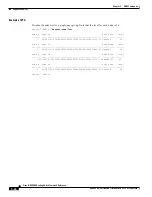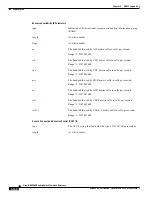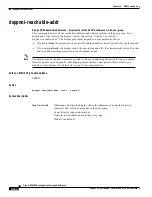
5-95
Cisco MGX 8850 Routing Switch Command Reference
Release 2.0, Part Number 78-10467-04 Rev C0, October 2001
Chapter 5
PNNI Commands
dsppnni-ptse
Cards on Which This Command Runs
PXM45
Syntax
dsppnni-ptse
[node-index [node-id [ptse-id]]]
[-detail {true | false}]
Syntax Description
Note
The parameters node-index, node-id, and ptse-id are nested. Therefore, you cannot enter node-id
without node-index, nor can you enter ptse-id without node-index and node-id.
Display Contents for dsppnni-ptse
This section describes basic information for each PTSE type. In addition, each variation of the command
output contains the following header information.
node-index
A unique, network-wide node identifier. This system-generated number has a range
of 1–256.
Range: 1–256.
Default: (no default)
node-id
The user-specified node ID. See addpnni-node or cnfpnni-node for a description.
Default: (no specific node ID)
ptse-id
An integer that identifies a PTSE generated by a particular node. Regardless of the
number of times a node sends a PTSE, this ID remains the same until a change to the
topology occurs. For example, adding a ATM address to a node causes that node to
generate a new PTSE and associated ID.
The PTSE ID has a theoretical limit of a 32 bit number. However, the PTSE ID is
likely to be a relatively small number.
-detail
Selects the amount of detail for the display.
true: Display the contents of the PTSE as well as the header information.
false: Display only the PTSE header.
Default: false
node-index
This unique, network-wide node identifier is a switch-generated
number in the range 1–256. If the network consists of a multi-peer
group, the display shows the sequence of node numbers for the
lowest level then starts the sequence at the next level.
originating node ID
The identifier of the node that broadcast the PTSE.
















































